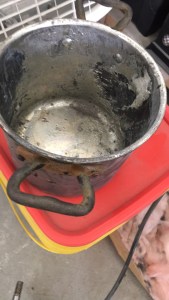 You know when you hear that something is “an art form”? And you understand, vaguely, what that means, but it has nothing to do with it being art per sae and everything to do with practice, trial and error, and just getting a *feel* for something. That’s what learning to re-tin copper cookware is like.
You know when you hear that something is “an art form”? And you understand, vaguely, what that means, but it has nothing to do with it being art per sae and everything to do with practice, trial and error, and just getting a *feel* for something. That’s what learning to re-tin copper cookware is like.
It’s freaking hard, man.
I’ve been slowly working at re-tinning copper cookware since June of 2016, and while I have more and more pieces I’m proud of, I also will get some pots that turn out awful. Or, as Dan, the master tinner mentoring me, mentioned recently: “well, you can always use that one as a Halloween prop with a witch sitting next to it, stirring…” Which is to say some pieces still look like death.

There are several steps to cleaning, refurbishing, and re-tinning copper. They are completely able to be written down and laminated and tacked to the shop wall. A lot of it requires elbow grease, face masks, and breathing equipment, or at least an air compressor and power tools. But that’s all the logistical part.
What’s tricky is the “art” part.
There’s a complete finesse to curling molten tin around inside a 600 degree copper pot and making it look good and perfect and uniform. When you add flux to get the copper and tin to bond, an opaque gray-white steam billows off, making a deep pot even harder to tin because you’re going in blind. Guaranteed you will come away with random burns. But a select, tiny, few people can make that tin look glossy and perfect and smooth every single time.
 I’m not there yet. There are many times the tin goes on exactly right and I’m thrilled beyond the moon. But I can still get drips, or the tin cools too quick and frosts, or the tin doesn’t stick as well and looks “ghostly”. And while all of these issues are purely cosmetic, and the pots are still completely functional, sometimes I get so frustrated by the lack of perfection I expect of myself. I know some of it is time – I need to put in the time and practice. Some of it is weather or wind or amount of flame used on a given day. Other times it’s the copper piece itself – its age, it’s pocking, its shape. But I still aspire to the art of tinning. And it’s possible for anyone to try their hand at it. Who knows? It may be the lost art you’ve been looking for…
I’m not there yet. There are many times the tin goes on exactly right and I’m thrilled beyond the moon. But I can still get drips, or the tin cools too quick and frosts, or the tin doesn’t stick as well and looks “ghostly”. And while all of these issues are purely cosmetic, and the pots are still completely functional, sometimes I get so frustrated by the lack of perfection I expect of myself. I know some of it is time – I need to put in the time and practice. Some of it is weather or wind or amount of flame used on a given day. Other times it’s the copper piece itself – its age, it’s pocking, its shape. But I still aspire to the art of tinning. And it’s possible for anyone to try their hand at it. Who knows? It may be the lost art you’ve been looking for…
Comments +